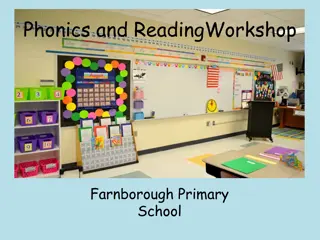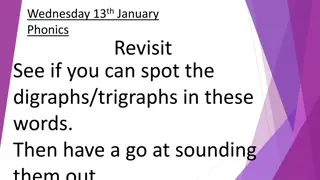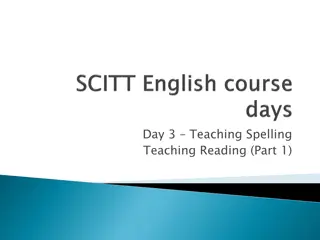Phonics. Why teach phonics?. Research and rationale.
Teaching phonics, the relationship between letters and sounds, is essential in language learning to improve reading skills. This content explores the significance of phonics instruction, its effectiveness in L2 learning, and the role of phonological decoding. It also discusses the importance of accurate pronunciation in foreign languages and the impact of phonics on students' progress in this area.
Download Presentation

Please find below an Image/Link to download the presentation.
The content on the website is provided AS IS for your information and personal use only. It may not be sold, licensed, or shared on other websites without obtaining consent from the author. Download presentation by click this link. If you encounter any issues during the download, it is possible that the publisher has removed the file from their server.
E N D
Presentation Transcript
Phonics Why teach phonics? Research and rationale
Discuss In your opinion, is it important to teach phonics (the relationship between letters and their sounds) in languages? Why/why not? Is phonics currently taught in your school? If so, how well? In your school, (a) how accurately and (b) how fluently can students pronounce written words in the foreign language? (consider both familiar and unknown words) How much progress do they make in this area? Robert Woore
Session outline 1. 2. 3. 4. Phonics in language teaching What is phonics teaching ? Definitions of key terms. The role of phonics in learning to read in L1 English Learning to read / decode in different writing systems a. Is phonological decoding important in L2? Why? b. Is phonics instruction effective in L2 learning? c. If so, effective in what ways? What are the outcomes? 5. Summary and key messages Robert Woore
1. Definitions Phonics teaching: explicit teaching of the relationships between letters and their sounds in written words Grapheme-Phoneme Correspondences (GPC) the systematic relationships between the graphemes and phonemes in a given writing system. Phoneme: minimal sound unit capable of contrasting word meaning (Katamba, 1989:21) ch aud ch au d Grapheme: a. written unit corresponding to a phoneme o o - Symbol-sound correspondences (SSC): the systematic relationships between the written symbols and sounds (at any unit of size) in a given writing system. Robert Woore
1. Definitions Phonological decoding (or recoding ): the ability to convert the visual print into its corresponding spoken form Nassaji (2013) < c a t > / k a t / CC0 license pixabay.com Word recognition / identification (or lexical access ): the skill with which readers process the visual symbols in the print in order to recognize and access its meaning in the mental lexicon Nassaji (2013) Robert Woore
1. Definitions un crino de jerette Phonological decoding Familiar words: phonological representations already stored in mental lexicon may be accessed as wholes Unfamiliar words / pseudowords: phonological forms must be generated at point of naming, using knowledge of the language s symbol-sound correspondences l ulmaire tir t Robert Woore
2. The role of phonics to read in L1 English The case for systematic phonic work is overwhelming and much strengthened by a synthetic approach (Rose, 2006:20) We will improve early numeracy and literacy, promoting systematic synthetic phonics and assessing reading at age six to make sure that all children are on track (DfE, 2010:43) Year 1 Phonics Screening Check in England Robert Woore
Types of phonics teaching Synthetic phonics Analytic phonics Children taught to recognize whole words first Then recognize patterns e.g. cat, cake, car, cup all start with <c> cap, rip, flap all end in <p> c a t cat Common exception words also taught e.g. of , the Emphasis on synthetic phonics is controversial The available research evidence supports systematic tuition in phonics at a variety of levels (e.g. phoneme, onset-rime) combined with meaningful experiences with print (Wyse & Styles 2007:40) Robert Woore
Evidence for the benefits of phonics is more established but over-emphasis on phonics is controversial! If we want England s children to get better at reading and to do more of it, we have to give them a diet that is attractive, nutritious and satisfying. Restricting them to an unbalanced diet, the thin gruel of a phonics-dominated approach, is a recipe for lowering standards and turning children against the written word. ( ) Children certainly need instruction in the techniques, but they only become effective and committed readers through reading texts that interest them (Dombey, 2010:13) Robert Woore
Theoretical underpinnings Gough & Tunmer (1986): Simple View of Reading (SVR) Reading comp. = Decoding (of written words) x Language comprehension Sounding out sine qua non of reading acquisition (Share, 1995) Allows children to discover the meaning of words Acts as a self-teaching mechanism / k a t / < c a t > In L1: beginner readers have a large bank of oral language knowledge to draw upon! Cat image: CC0 license pixabay.com Robert Woore
Orthographic depth m sica <u> <i> <a> Orthographic depth: a measure of how consistent / transparent the mappings are between graphemes and phonemes in a given writing system. European languages differ in their orthographic depth! /u/ /i/ /a/ Robert Woore
Orthographic depth to /u/ (through) moo / f/ (cough) two / / (though) through / / (thought) shoe /a / (bough) flew / / (thorough) flu / x/ (lough) blue Robert Woore
Orthographic depth vers verre verres ver verts * vaire * vaires vert vair * verd Robert Woore
Awareness-raising tasks and analogies like these may be useful for MFL students! Robert Woore
It might sometimes be useful to teach students the relationships between larger orthographic unit beyond individual graphemes. For example, in French: -tion -sion -eur -er -aine -aille -ille -ine -ez -ail -euille Hence, we re using the term SSC (symbol-sound correspondences) rather than GPC Robert Woore
Session outline 1. 2. 3. 4. Phonics in language teaching What is phonics teaching ? Definitions of key terms. The role of phonics in learning to read in L1 English Learning to read / decode in different writing systems a. Is phonological decoding important in L2? Why? b. Is phonics instruction effective in L2 learning? c. If so, effective in what ways? What are the outcomes? 5. Summary and key questions for my own classroom Robert Woore
2. The importance of decoding L2 English In L1 it s all about reading comprehension! discovering the meaning of words you already know orally. BUT in many instructed contexts (including MFL), learners make contact with written forms at the very onset of learning the language Robert Woore
2. The importance of decoding L2 English One benefit of developing accurate letter-sound correspondences is lost in most L2 settings; that is, L2 students cannot match a sounded-out word to a word that they know orally because they do not yet know the word orally. Grabe and Stoller, 2011 But! Emerging evidence that there being able to decode accurately in L2 may have a positive impact on many aspects of language learning, including: Reading comprehension, Vocabulary learning (Hamada & Koda, 2008, 2011; Li, in progress), Learner autonomy, Grammar learning (Erler, 2003), Motivation (Erler & Macaro, 2011), Speaking, Listening, Writing (Macaro, 2007) Robert Woore
How good are UK L2 learners at decoding? Think about pupils in your own classrooms, in different year groups. How accurately (and fluently) can they pronounce L2 words? Research in UK MFL classrooms suggests that, in the absence of explicit instruction: students are not very good at phonological decoding (reading aloud); they seem to make little progress in this area; English spelling-sound links remain stubbornly entrenched; Students may know that words should sound different to English, but not know how they should sound. (Sources: Erler, 2003, 2004; Erler & Macaro, 2012; Porter, 2014, forthcoming; Woore, 2009, 2010, 2011, 2014, 2018) Robert Woore
These words get more ridiculous as we go along Some of these don't even look like real words. I reckon you're just trying to trick me I don't know because most of them look like gibberish basically They're like really weird words, like they don't exist Robert Woore
Can we teach phonics in languages? There is significant evidence, including from the most effective practitioners, that direct and systematic teaching of phonics in the new language is a more reliable method for assuring accurate pronunciation and spelling. However, this is still relatively rare practice in classrooms (TSC, 2016:12) Phonics is the cornerstone of the approach to language teaching in my school and it works The consequence is also a learner who is able to understand more text containing unfamiliar language, a learner who is more confident in speaking and reading out loud in the foreign language, and a more autonomous learner who is able to make links between words and apply patterns. www.rachelhawkes.com/Resources/ Phonics/Phonics.php Robert Woore
Can we teach phonics in languages? What is the research evidence? Limited research evidence on teaching Phonics in foreign languages Three small-scale examples: doctoral studies (2 in UK MFL context) Recent larger-scale study: FLEUR project (see pdcinmfl.com) 1. Woore (2011) Method: Quasi-experimental study: 200 x Year 7 students, 4 schools, 6 intervention classes and 6 control. Year-long Phonics programme in Y7. Findings: Small but significant advantage for Phonics group over control group in decoding progress. Limitations: Effects on other outcomes not measured at what cost? Little opportunity to practise SSC as part of a wider programme of L2 reading No delayed post-test: was learning sustained? Robert Woore
2. Porter (2014) Method. Combined oracy-and-literacy intervention (including phonics) in 2 primary school classrooms, lasting 24 weeks. Pre-, post-, delayed post-tests. Findings. Children improved at reading aloud over the intervention but the learning faded once the teaching stopped. Limitations. No control group therefore cannot know whether the improvements resulted from the intervention or other teaching 3. Li (forthcoming) Method. Chinese university students learning English as a Foreign Language. 12 weeks of systematic phonics covering 101 English GPC. Control group had phonology training, but no Phonics. Findings. Phonics group made significantly more progress than control group in (a) phonological decoding and (b) intentional vocabulary learning. Limitations. No delayed post-tests. Teaching done by the researcher, not by usual teachers: is this scalable? Robert Woore
French Language Education: Unlocking Reading (FLEUR) Woore et al. (2018) Experimental study (Randomized Control Trial) Pre-, post-, delayed post-test design c. 900 students in 36 schools nationally (33 comprehensive, 3 grammar) Intervention phase lasted 16 weeks, c.25 minutes per week Interventions delivered by usual class teachers Phonics Strategy instruction Challenging texts Challenging texts Challenging texts Phonological decoding Vocabulary Self-efficacy Reading comprehension Motivation Strategic behaviour Teachers / students views Robert Woore
Fleur project- phonics programme Target graphemes: 1. SFC* & SFe* 2. i/ie 3. SFe* 4. (+ ez e er) 5. ou / u 6. en / an 7. qu / ch / 8. eau / au 9. -ation, -ition 10. in / ain / ien 11. oi / eu 12. eu 13. / / ai Choice of target graphemes made collaboratively with teachers Based on: (a) difficulty for English speakers; (b) frequency in the language (more detail on this in half-day sessions!) 4 aspects of instruction: Awareness raising differences between English and French writing systems Introducing new SSC Practising new SSC controlled practice and open-ended practice (challenging texts) Recapping of SSC already covered Note: SFC = Silent Final Consonants; SFe = Silent Final <e> Robert Woore
Fleur study- findings (pre- / post- tests) Explicit phonics instruction led to significantly greater progress in phonological decoding (after controlling for prior attainment) Pen-and-paper decoding test: less sensitive than Reading Aloud Task, so actual gains may have been greater! No difference between groups in reading comprehension outcomes Phonics group made significantly more gains in vocabulary knowledge Vocab knowledge is known to be a key contributor to all language skills! Decoding score 6-7 percentage points higher Estimated vocabulary knowledge (t2): 2000 most frequent French words Robert Woore
Session outline 1. 2. 3. 4. Phonics in language teaching What is phonics teaching ? Definitions of key terms. The role of phonics in learning to read in L1 English Learning to read / decode in different writing systems a. Is phonological decoding important in L2? Why? b. Is phonics instruction effective in L2 learning? c. If so, effective in what ways? What are the outcomes? 5. Summary and key questions for my own classroom Robert Woore
Summary of key points arising from research Phonics can be taught in languages it helps develop phonological decoding Without phonics, progress in phonological decoding may be limited Teaching needs to be sustained. SSC in the foreign language need to be mastered and stable and ultimately, automatized There is no apparent detriment to reading comprehension, despite the time spent on explicit phonics teaching. In L1, Phonics is all about reading comprehension. But in L2/3, the benefits appear to be wider. Phonics may benefit learner autonomy and vocabulary learning in particular and vocabulary knowledge is key to foreign language learning! Robert Woore
Summary of key points arising from research More work is needed to identify the most effective ways of teaching phonics in MFL, but these likely include: Awareness raising of differences between L1/L2 writing systems Explicit teaching of key symbol-sound correspondences (SSC) (not necessarily only GPC!) focussing on those most different from L1 Plenty of practice, to reinforce SSC knowledge and develop automaticity A rich diet of reading material alongside any focussed phonics practice to promote motivation Phonics may be easier to teach in shallow orthographies (e.g. Spanish, German, Italian) than in French. In French, more sustained effort may be needed, but there is still payback for the learner. Robert Woore
Key take-home messages 1. Plan and teach it, as it seems to help a LOT of things. 2. Keep going with it (especially French). 3. Keep testing it (especially French). Robert Woore
References Cook, V. and Bassetti, B. (2005b) An introduction to researching Second Language Writing systems , in V. Cook & B. Bassetti (eds.) (2005) Second Language Writing systems. Clevedon: Multilingual Matters, pp. 1-70. Daller, H., Milton, J. and Treffers-Daller, J. (2007) Editors introduction: conventions, terminology and an overview of the book . In H. Daller, J. Milton and J. Treffers-Daller (Eds.), Modelling and Assessing Vocabulary Knowledge. Cambridge: Cambridge University Press, pp. 1-32 DfE (2010) The Importance of Teaching: The Schools white paper 2010. London: Department for Education. Dombey, H. (2010) Teaching Reading: What the Evidence Says. Leicester: UKLA. Erler, L. (2003) Reading in a Foreign Language Near-Beginner Adolescents Experiences of French in English Secondary Schools. DPhil Thesis, Oxford University. Erler, L. (2004) Near-Beginner Learners of French Are Reading at a Disability Level . Francophonie, vol. 30, pp. 9-15. Erler, L. and Macaro, E. (2012) Decoding Ability in French as a Foreign Language and Language Learning Motivation . The Modern Language Journal, 95(4): 496-518. Gough, P. B. and Tunmer, W. E., 1986. Decoding, reading, and reading disability. Remedial and special education, 7(1), pp.6-10. Grabe, W. and Stoller, F. L. (2011) Teaching and researching reading. London: Longman. Hamada, M. and Koda, K. (2008) Influence of First Language Orthographic Experience on Second Language Decoding and Word Learning . Language Learning, vol. 58, no. 1, pp.1-31. Robert Woore
References Hamada, M. and Koda, K. (2011) The role of the phonological loop in English word learning: A comparison of Chinese ESL learners and native speakers . Journal of Psycholinguistic Research, 40(2), pp.75-92. Katamba, F. (1989) An Introduction to Phonology. London:Longman. Macaro, E. (2007) Do beginner learners of French have any writing strategies? Language Learning Journal, 35, pp. 23 36. Nassaji, H. (2014) The role and importance of lower-level processes in second language reading . Language Teaching, 47(1): 1-37. Odlin, T. (1989) Language Transfer: Cross-linguistic influence in language-learning. Cambridge: Cambridge University Press. Porter, A.M. (2014) An early start to French literacy: Learning the spoken and written word simultaneously in English primary schools. PhD thesis, University of Southampton. Rose, J. (2006) Independent review of the Teaching of Early Reading: Final Report. London: DfES. Seymour, P. H. K., Aro, M. and Erskine, J. M. (2003) Foundation Literacy Acquisition in European Orthographies . British Journal of Psychology, vol. 94, pp. 143 174. Share, D. L. (1995) Phonological recoding and self-teaching: sine qua non of reading acquisition . Cognition, vol. 55, pp. 151-208. Woore, R. (2007) Weisse Maus in Meinem Haus : Using Poems and Learner Strategies to Help Learners Decode the Sounds of the L2 . Language Learning Journal, vol. 35, no. 2, pp. 175-188. Robert Woore
References Woore, R. (2009) Beginners progress in decoding L2 French: some longitudinal evidence from English Modern Foreign Languages classrooms . Language Learning Journal, vol. 37, no. 1, pp. 3-18. Woore, R. (2010) Thinking aloud about L2 decoding: an exploration into the strategies used by beginner learners when pronouncing unfamiliar French words . Language Learning Journal, vol. 38, no. 1, pp. 3-17. Woore, R. (2011) Investigating and developing beginner learners decoding proficiency in second language French: an evaluation of two programmes of instruction. Unpublished PhD thesis, University of Oxford. Woore, R. (2014) Beginner learners progress in decoding L2 French: transfer effects in typologically similar L1-L2 writing systems . Writing Systems Research, volume 4(2): 167-189. Woore, R (2018) Learners pronunciations of familiar and unfamiliar French words: what can they tell us about phonological decoding in an L2? The Language Learning Journal, 46(4):456-69. Woore, R., Graham, S., Porter, A., Courtney, L. and Savory, C. (2018) Foreign Language Education: Unlocking Reading (FLEUR) - A study into the teaching of reading to beginner learners of French in secondary school. https://ora.ox.ac.uk/objects/uuid:4b0cb239-72f0-49e4-8f32-3672625884f0 Wyse, D. and Styles, M. (2007) Synthetic phonics and the teaching of reading: the debate surrounding England s Rose Report . Literacy, 41(1), pp. 35-42 Ziegler, J. and Goswami, U. (2005) Reading Acquisition, Developmental Dyslexia and Skilled Reading Across Languages: A Psycholinguistic Grain Size Theory . Psychological Bulletin, vol. 131, no. 1, pp. 3-29. Robert Woore























